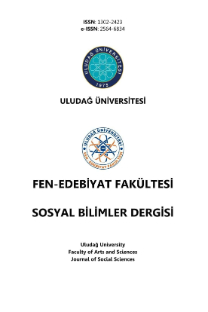KİTLELERİN ÇEVRİM İÇİ ORTAMLARDA SANAT ÜRETİMİNE KATILIMI VE KİTLE KAYNAK UYGULAMALARI: “TRANSFORMERS PREMAKE”
Yeni iletişim teknolojileri ve telekomünikasyonun gelişmesi ile dünyanın politik, iktisadi ve kültürel olarak farklı biçimde şekillenmesi söz konusudur. Özellikle 20. yüzyılın ikinci yarısından sonra gerçekleşen toplumsal, kültürel, ekonomik değişimlerin bireyleri biçimlendirdiği ve yeni bir toplum modeli oluştuğu iddia edilmektedir. Etkileşim, paylaşım, bilgiye erişimde kolaylık, bağımsız ve kolektif içerik üretimi gibi kavramların önem kazanması ile bireylerin yaşam pratiklerinde var olan değişim, sanat alanına da yansımaktadır. Günümüzde sanatçılar, işbirliği içerisinde üretilen sanat eserlerine ağırlık vermeye başlamış ve sanat oluşumları, potansiyel katılımcı olarak daha geniş kitlelere ulaşım için uygun ortamı bulmuşlardır. Çevrim içi ortamlarda mekânsal ve zamansal olarak bir aradalık gerektirmeksizin ortak üretim sağlaması nedeni ile “kitle kaynak” uygulamaları sanat ürünlerinin üretiminde sanatçıların/amatörlerin kullandığı bir yöntem olarak yaygınlaşmaktadır. Yeni mecranın gerektirdiği bu değişim ile sanatsal üretimde demokratikleşme iddiaları söz konusu olduğu gibi, üretime katılan üre-tüketicilerden bahsetmek olasıdır. Çalışma kitle kaynak kavramına ve uygulanışına dair temel bilgilerin sunulması sonrasında seçilen çalışma “Transformers Premake” adlı belgesel üzerinden kitle kaynak uygulamalarını örneklendirmeyi amaçlamaktadır.
Online Community Engagement Practices in Filmmaking: “Transformers Premake”
With the development of new communication technologies, it is accepted that the world is shaped in a different way in terms of political, economic and social patterns. Especially after the second half of the 20th century, it is claimed that the social, cultural and economic changes that take place parallel to the changes in the means of communication changed individuals and formed a new model of society. Along with these developments, artists have started to give importance to the artworks produced collectively. Also, artists change to reach broader masses that are possible participants for their products. Despite the diversity of the digital environment and lack of physical intervention that is at the root of participatory art, with these new online practices, there is a need to evaluate online and offline participatory arts activities, including on-line participatory art events. This article includes traces the changing social practices of audiences in terms of digitalization and how they have been involved in the art-making process through “Crowdsourcing”. Throughout the research, the concepts of connectivity and collectivity are aimed to be analyzed by a specific example of a desktop documentary, “Transformers Premake” that aims to explore the changing form and aesthetic in filmmaking besides the production method which is also related to users’ engagement and crowdsourcing.
___
- Baker, Ulus (2009). “İnternette Sanat Mümkün mü?”. Körotonomedya. http://korotonomedya.net/kor/index.php?id=6,7,0,0,1,0%20eri%C5%9F im%20tarihi%2021%20Aral%C4%B1k%202009 (Erişim tarihi 18.07.2018)
- Banger, Gürcan ve Gülsüm Çalışır (2014). “Sosyal Medyanın Kurumsal İnnovasyon İçin Kitle Kaynak Olarak Kullanımı”. Uluslararası Yeni Medya – Yeni Yaklaşımlar Konferansı, Çanakkale Onsekiz Mart Üniversitesi, 8-9 Mayıs 2014, s. 684-697.
- Becker, Howard (1984). Art Worlds. Berkeley, CA: University of California Press.
- Bone, Steven (2014). “Kevin B. Lee’s Transformers Premake”. Roger Ebert.com. https://www.rogerebert.com/balder-and-dash/kevin-b-lees-transformersthe-premake (Erişim tarihi 15.06.2018)
- Bourriaud, Nicholas (2006). Relational Aesthetics. In C. Bishop (Ed.), Participation Cambridge, MA: MIT Press, s. 160-171.
- Erdal, Cengiz (2013). “Sosyal Medya ve Paylaşım Kültürü”. Kültür, Kimlik, Siyaset içinde, Ed. C. Bilgili ve G. Şener, İstanbul: Reklam Yaratıcıları Derneği.
- González, Fernando ve Ladron de Guevara (2012). “Towards an Integrated Crowdsourcing Definition”. Journal of Information Science, S. XX (X), s. 1-14.
- Hepkon, Zeliha (drl.) (2011). İletişim ve Teknoloji. İstanbul: Kırmızı Kedi Yayıncılık.
- Howe, Jeff (2010). Crowdsourcing: Kalabalıkların Gücü Bir İşin Geleceğine Nasıl Şekil Verebilir?. Çev. Günseli Aksoy, İstanbul: Optimist Yayıncılık.
- Howe, Jeff (2006). “The Rise of Crowdsourcing”. Wired. C. 14, S. 6, s. 1-5.
- Jenkins, Henry (2006a). Convergence Culture, Where Old and New Media Collide. New York: NYU Press.
- Jenkins, Henry (2006b). Fans, Bloggers, and Gamers: Exploring Participatory Culture. New York: NYU Press.
- Jenkins, Henry vd. (2009). Confronting The Challenges of a Participatory Culture: Media Education For The 21st Century. London: The MIT Press.
- Lee, B. Kevin (2014). “Transformers Premake”. https://www.alsolikelife.com/premake-1(Erişim tarihi: 18.01.2018)
- Levy, Pierre (2001).”Collective Intelligence”. In David Trend (ed.), Reading Digital Culture. Malden Mass: Blackwell, s. 253-259.
- Lister, Martin vd. (2009). New Media: A Critical Introduction. London: Routledge.
- Literat, Ioana (2012). “The Work of Art in the Age of Mediated Participation: Crowdsourced Art and Collective Creativity”. International Journal of Communication, C. 6, s. 2962-2984.
- Macnab, Geoffrey (2018). “‘If Movies Disappeared Overnight, I Wouldn’t Care’: David Cronenberg on the Death of Cinema”. TheIndyFilm. Independent. 18.07.2018. https://www.independent.co.uk/arts-entertainment/films/features/davidcronenberg-death-of-cinema-film-novel-golden-lion-the-fly-nakedlunch-a8450566.html (Erişim tarihi: 11.08.2018)
- Manovich, Lev (2001). The Language of New Media. London: The MIT Press Cambridge.
- Thomas, Malone (2006). “What is Collective Intelligence and What Will We Do About It?”. http://cci.mit.edu/about/MaloneLaunchRemarks.html (Erişim tarihi: 03.01.2014)
- Tryon, Chuck (2010). “Reinventing Cinema: An Interview with Chuck Tryon (Part One)”. Confessions of An Aca-Fan. http://henryjenkins.org/2010/07/throughout_the_book_you_addres.html #sthash.SxtifUCU.d uf (Erişim tarihi: 20.12.2014)
- Virilio, Paul (2003). Enformasyon Bombası. Çev. Kaya Şahin, İstanbul: Metis.
- ISSN: 1302-2423
- Yayın Aralığı: Yılda 2 Sayı
- Başlangıç: 1999
- Yayıncı: Bursa Uludağ Üniversitesi
Sayıdaki Diğer Makaleler
VAN - HAKKÂRİ İLLERİ KÜLTÜR VE SANATINDA KUŞLAR
BURSA DAĞ YÖRESİNDEN (KELES VE ORHANELİ İLÇELERİNDEN) DERLEME SÖZLÜĞÜ’NE KATKILAR
BALKAN GÖÇMENLERİNİN SİVİL TOPLUM KURULUŞLARINA İLGİSİ
Joseph Conrad’ın Zafer ve Yusuf Atılgan’ın Aylak Adam Romanlarında Aşktan Kaçınan Erkekler
Edwin Muir’in Travma, Sürgün ve Kayıp Şiirlerinde Sığınma Mekânları
İKİNCİL TRAVMATİK STRESİN MESLEK ELEMANLARI ÜZERİNDEKİ ETKİLERİ: BİR DERLEME ÇALIŞMASI
OSMANLI DEVLETİ’NİN SON DÖNEMİNDE TRAFİK VE TRAFİK KAZALARI
DESIGN OF A ROBOTIC TOY AND USER INTERFACES FOR AUTISM SPECTRUM DISORDER RISK ASSESSMENT
